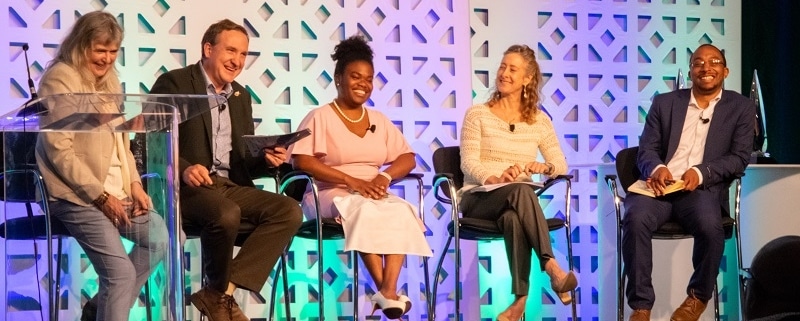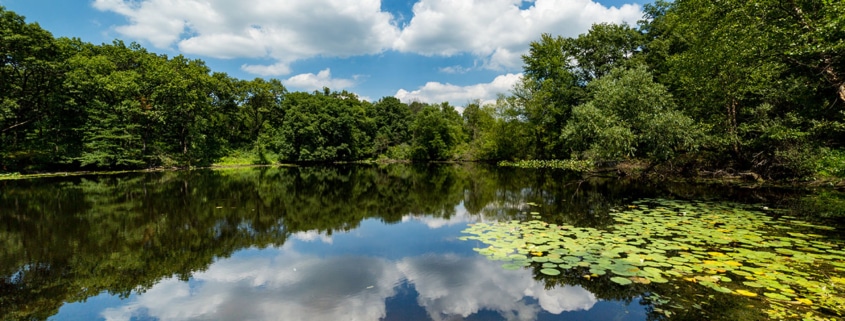Conservation in Charm City – A Conservation Conference Recap
For WHC members, staff, partners and programs, a trip to a new city is not complete without a tour of the conservation and community engagement efforts happening in the area. At this year’s WHC Conservation Conference, this tour was accomplished via a mainstage panel featuring representatives from the National Aquarium, Biohabitats, the Waterfront Partnership of Baltimore and Urban Wood Economy, moderated by WHC President Margaret O’Gorman. The panelists discussed building trust with local communities, increasing engagement and co-designing projects with the community.
Curtis Bennett, Director of Equity and Community Engagement at the National Aquarium started the discussion focusing on the importance of psychological safety when working with communities. He defined this as “moving at the speed of trust” – understanding that building trust with communities can take years to build and seconds to destroy.
Bennett also honed in on the value of actively listening to communities’ needs and recognizing that spaces hold value to community members even when it may not be immediately apparent to potential corporate partners. Trusting that residents are the experts in their own neighborhood means centering and valuing people’s lived experiences, and ensures that corporations, foundations and other external entities build a strong foundation of trust and respect.
Tanaira Cullens, Environmental Scientist at Biohabitats and contributor to the Baltimore Ecosystem Study, echoed this sentiment and recommended communicating with community members in a way that best reaches them by using plain language and avoiding unfamiliar acronyms. She also recommended researching the most commonly spoken languages in a community and creating written materials in those languages, as well as ensuring that individuals who are Deaf or head of hearing have meaningful access to educational materials and events.
On the topic of making learning accessible, Adam Lindquist, Vice President of the Healthy Harbor Initiative with the Waterfront Partnership of Baltimore, spoke on the role of Mr. Trash Wheel in inspiring learning. This trash interceptor decorated with two large, googly eyes has been operating in Baltimore’s Inner Harbor since 2014. Lindquist explained that the popularity and novelty of Mr. Trash Wheel increases the community’s awareness of the trash they’re generating, encouraging them to reduce their waste and find creative ways to recycle. Mr. Trash Wheel’s fan following even led to the creation of The Order of the Wheel, a “not-so-secret” society where members pledge to reduce usage of single-use plastics and clean up litter. This nod to the community’s enjoyment of Mr. Trash Wheel further increases the community’s connection to their local watershed.
In addition to feeling connected to the harbor, community members also tend to have deep connections with the trees around them, explained Jennifer Judd, Director of Partnership and Outreach at Urban Wood Economy. For Urban Wood Economy, an organization that repurposes used wood from construction sites as well as down urban trees, acknowledging the community’s connection to these trees was paramount. Judd explained that in addition to capturing carbon and promoting reuse of materials, reusing urban wood also creates jobs, thereby reinvesting in the community. By working as partners with community members, Judd explained that Urban Wood Economy can serve as the “glue” of an urban wood reuse project, providing logistical support when the community has a vision for repurposing local trees.
A common refrain throughout the panel discussion was the importance of soliciting feedback in a manner that respects the community’s involvement. Bennett discussed the critical value of ensuring that community members have an active role in co-creating conservation or education projects, and the panelists each spoke on how to solicit feedback, adjust curricula or solve unexpected issues without taking ownership of the project away from its community stakeholders. Cullens closed with a helpful reminder to companies unsure about how to start making meaningful connections with the community. “Community engagement does not need to be a burden,” she said. “It can also be a benefit to your company’s bottom line.”
Connect with the panelists on LinkedIn:
Learn more about community-first environmental action: https://tandemglobal.org/knowledge-resource/community-first-environmental-action-white-paper/




